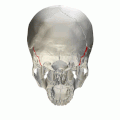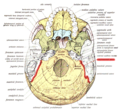Occipitomastoid suture
Occipitomastoid suture is a cranial suture that connects the occipital bone and the mastoid part of the temporal bone. It is located at the base of the skull and is one of the many sutures that make up the cranium.
Anatomy[edit]
The occipitomastoid suture begins at the jugular foramen, a large opening in the base of the skull that allows for the passage of several important structures, including the internal jugular vein and several cranial nerves. From there, it extends laterally to the external acoustic meatus, or the opening of the ear canal.
The occipitomastoid suture is a synarthrosis, meaning it is a joint that allows for very little movement. Like all cranial sutures, it serves to connect and secure the bones of the skull, providing protection for the brain and other structures within the cranium.
Clinical significance[edit]
In some cases, the occipitomastoid suture may be involved in certain medical conditions or procedures. For example, it may be affected by craniosynostosis, a condition in which the sutures of the skull fuse prematurely, leading to abnormal skull shape and potential complications with brain development.
Additionally, the location of the occipitomastoid suture near the jugular foramen means that it may be involved in surgical procedures or other interventions involving this area.
See also[edit]
|
|
|
-
Occipitomastoid suture - skull - lateral view
-
White Desert Skull Cropped - Occipitomastoid suture
-
Occipitomastoid suture - animation 03
-
Occipitomastoid suture - animation 06
-
Occipitomastoid suture - skull - inferior view
-
Sobo 1909 42 - Occipitomastoid suture
Ad. Transform your life with W8MD's Budget GLP-1 injections from $75


W8MD offers a medical weight loss program to lose weight in Philadelphia. Our physician-supervised medical weight loss provides:
- Weight loss injections in NYC (generic and brand names):
- Zepbound / Mounjaro, Wegovy / Ozempic, Saxenda
- Most insurances accepted or discounted self-pay rates. We will obtain insurance prior authorizations if needed.
- Generic GLP1 weight loss injections from $75 for the starting dose.
- Also offer prescription weight loss medications including Phentermine, Qsymia, Diethylpropion, Contrave etc.
NYC weight loss doctor appointmentsNYC weight loss doctor appointments
Start your NYC weight loss journey today at our NYC medical weight loss and Philadelphia medical weight loss clinics.
- Call 718-946-5500 to lose weight in NYC or for medical weight loss in Philadelphia 215-676-2334.
- Tags:NYC medical weight loss, Philadelphia lose weight Zepbound NYC, Budget GLP1 weight loss injections, Wegovy Philadelphia, Wegovy NYC, Philadelphia medical weight loss, Brookly weight loss and Wegovy NYC
|
WikiMD's Wellness Encyclopedia |
| Let Food Be Thy Medicine Medicine Thy Food - Hippocrates |
Medical Disclaimer: WikiMD is not a substitute for professional medical advice. The information on WikiMD is provided as an information resource only, may be incorrect, outdated or misleading, and is not to be used or relied on for any diagnostic or treatment purposes. Please consult your health care provider before making any healthcare decisions or for guidance about a specific medical condition. WikiMD expressly disclaims responsibility, and shall have no liability, for any damages, loss, injury, or liability whatsoever suffered as a result of your reliance on the information contained in this site. By visiting this site you agree to the foregoing terms and conditions, which may from time to time be changed or supplemented by WikiMD. If you do not agree to the foregoing terms and conditions, you should not enter or use this site. See full disclaimer.
Credits:Most images are courtesy of Wikimedia commons, and templates, categories Wikipedia, licensed under CC BY SA or similar.
Translate this page: - East Asian
中文,
日本,
한국어,
South Asian
हिन्दी,
தமிழ்,
తెలుగు,
Urdu,
ಕನ್ನಡ,
Southeast Asian
Indonesian,
Vietnamese,
Thai,
မြန်မာဘာသာ,
বাংলা
European
español,
Deutsch,
français,
Greek,
português do Brasil,
polski,
română,
русский,
Nederlands,
norsk,
svenska,
suomi,
Italian
Middle Eastern & African
عربى,
Turkish,
Persian,
Hebrew,
Afrikaans,
isiZulu,
Kiswahili,
Other
Bulgarian,
Hungarian,
Czech,
Swedish,
മലയാളം,
मराठी,
ਪੰਜਾਬੀ,
ગુજરાતી,
Portuguese,
Ukrainian








